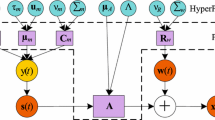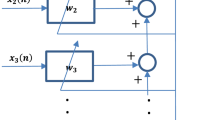Abstract
Independent component analysis is a fundamental and important task in unsupervised learning, that was studied mainly in the domain of Hebbian learning. In this paper, the temporal dependencies are explained by assuming that each source is an autoregressive (AR) process and innovations are independently and identically distributed (i.i.d). First, the likelihood of the model is derived, which takes into account both spatial and temporal information of the sources. Next, batch and on-line blind source separation algorithms are developed by maximizing likelihood function, and their local stability analysis are introduced simultaneously. Finally, computer simulations show that the algorithms achieve better separation of the mixed signals and mixed nature images which are difficult to be separated by the basic independent component analysis algorithms.
Similar content being viewed by others
Explore related subjects
Discover the latest articles, news and stories from top researchers in related subjects.References
Hyvärinen A, Karhunen J, Oja E (2001) Independent component analysis. Wiley, New York
Jutten C, Hérault J (1991) Blind separation of sources, part I: an adaptive algorithm based on neuromimetic architecture. Signal Process 24: 1–10
Common P (1994) Independent component analysis—a new concept?. Signal Process 36: 287–314
Tong L, Liu R-W, Soon VC, Huang Y-F (1991) Indeterminacy and identifiability of blind identification. IEEE Trans Circuit Syst 38: 499–509
Molgedey L, Schuster HG (1994) Separation of a mixture of independent signals using time delayed correlations. Phys Rev Lett 72: 3634–3636
Belouchrani A, Abed Meraim K, Cardoso J-F, Moulines E (1997) A blind source separation technique based on second order statistics. IEEE Trans Signal Process 45(2): 434–444
Pham D-T (2001) Blind separation of instantaneous mixtures of sources via the Gaussian mutual information criterion. Signal Process 81: 855–870
Ziehe A, Müller K-R (1998) TDSEP—an efficient algorithm for blind separation using time structure. In: Proc. Int. Conf. on Artificial Neural Networks (ICANN’98), Skövde, Sweden, pp 675–680
Kawamoto M, Matsuoka K, Oya M (1997) Blind separation of sources using temporal correlation of the observed signals. IEICE Trans Fund E80-A(4): 695–704
Amari S-I (2000) Estimating functions of independent component analysis for temporally correlated signals. Neural Comput 12(9): 2083–2107
Degerine S, Malki R (2000) Second-order blind separation of sources based on canonical partial innovations. IEEE Trans Signal Process 48(3): 629–641
Hyvärinen A (2001) Complexity pursuit: separating interesting component from time-series. Neural Comput 13(4): 883–898
Müller K-R, Philips P, Ziehe A (1999) JADE TD : combining higher-order statistics and temporal information for blind source separation (with noise). In: Proc. int. Workshop on independent component analysis and signal separation (ICA’99), Aussois, France, pp 87–92
Hild II KE, Attias HT, Nagarajan SS (2006) An EM method for spatio-temporal blind source separation using an AR-MOG source model. In: Proc. Int. Workshop on independent component analysis and signal separation (ICA’06), Charleston, USA, pp 98–105
Moulines E, Cardoso JF, Gassiat E (1997) Maximum likelihood for blind source separation and deconvolution of noisy signals using mixture models. In: Proc. IEEE Int. Conf. on acoustics, speech, and signal processing, Munich, Germany, pp 3617–3620
Pearlmutter BA, Parra LC (1996) A context-sensitive generalization of ICA. In: Proc. Int. Conf. on neural information processing, Hong Kong, pp 151–157
Xu L (2007) One-bit-matching theorem for ICA, convex-concave programming on polyhedral set, and distribution approximation for combinatorics. Neural Comput 19(2): 546–569
Liu ZY, Chiu KC, Xu L (2004) One-bit-matching conjecture for independent component analysis. Neural Comput 16(2): 383–399
Amari S-I, Chen TP, Cichocki A (1997) Stability analysis of learning algorithms for blind source separation. Neural Networks 10: 1345–1351
Amari S-I, Cichocki A, Yang HH (1996) A new learning algorithm for blind source separation. In: Advances in neural information processing systems, vol 8, MIT Press, Cambridge, pp 757–763
Pajunen P (1998) Blind source separation using algorithmic information theory. Neurocomputing 22: 35–48
Hyvärinen A, Oja E (1997) A fast fixed-point algorithm for independent component analysis. Neural Comput 9(7): 1483–1492
Author information
Authors and Affiliations
Corresponding author
Rights and permissions
About this article
Cite this article
Yang, Y., Guo, C. & Xia, Z. Independent Component Analysis for Time-dependent Processes Using AR Source Model. Neural Process Lett 27, 227–236 (2008). https://doi.org/10.1007/s11063-008-9071-3
Received:
Accepted:
Published:
Issue Date:
DOI: https://doi.org/10.1007/s11063-008-9071-3




